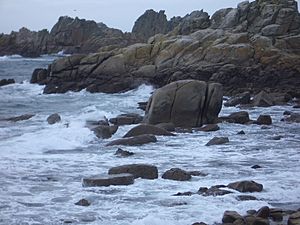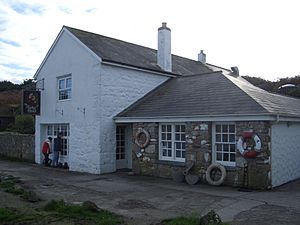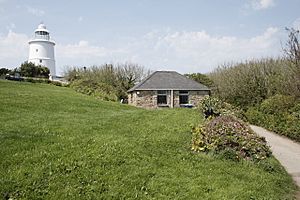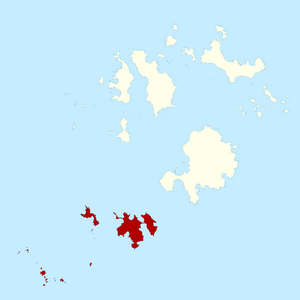St Agnes, Isles of Scilly facts for kids
Quick facts for kids St. Agnes
|
|
|---|---|
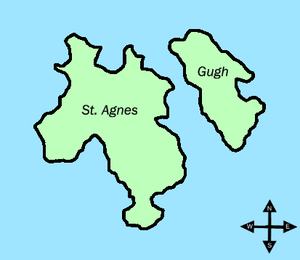 A map of St. Agnes with Gugh to the east. |
|
| Population | 82 (2011) |
| OS grid reference | SV881430 |
| Civil parish |
|
| Unitary authority | |
| Ceremonial county | |
| Region | |
| Country | England |
| Sovereign state | United Kingdom |
| Post town | ISLES OF SCILLY |
| Postcode district | TR22 |
| Dialling code | 01720 |
| Police | Devon and Cornwall |
| Fire | Isles of Scilly |
| Ambulance | South Western |
| EU Parliament | South West England |
| UK Parliament |
|
St Agnes (which is Agenys in Cornish) is the most southern island where people live in the Isles of Scilly. A place called Troy Town Farm on the island is the very southernmost settlement in the whole United Kingdom.
Contents
About St Agnes Island
St Agnes is connected to another island called Gugh by a natural bridge of sand. This sand bridge is called the Gugh Bar. You can only see it and walk across it when the tide is low. Gugh also has a few people living on it, usually around three residents.
Together, St Agnes and Gugh had 85 people living there in 2011. Their total land area is about 366 acres (148 hectares). If you only count St Agnes, it's a little smaller than Bryher in both population and size. But if you include Gugh with St Agnes, then Bryher is slightly smaller.
Life on the Island
In the past, many men from St Agnes worked as pilots. They would guide large ships, like transatlantic liners, safely through the English Channel. Today, the main way people make a living is through tourism. Some people also farm bulbs, like flowers.
There aren't many places to stay on St Agnes. It's the only island in the Isles of Scilly with people living on it that doesn't have a hotel. However, you can find some B&Bs and cottages to rent. There's also an ice cream shop, a campsite, a small post office with a general store, and a gift shop. The island has one pub, called the Turk's Head, and a cafe. These places usually close during the winter months.
Most of the people live in the northern and middle parts of the island. The southern end of St Agnes is covered by heather moorland. This area is known as Wingletang Down.
Famous Landmarks
The most famous landmark on St Agnes is its lighthouse. This lighthouse no longer has a light, and it has been turned into homes.
Another interesting landmark is a large rock formation called the Nag's Head. It looks like a standing stone, but it's probably a natural rock shape. In 1707, a terrible naval disaster happened near the Isles of Scilly. Many sailors drowned, and it's believed that some of them were buried on the St Agnes playing field.
The Troytown Maze is a very old landmark. People say it was made by the lighthouse keeper's son in 1729. However, it might be much, much older than that. Even though it's called a maze, it's actually a labyrinth. This means it has one long, winding path that leads you to the center. It's special because it's the only one outside of Scandinavia made from beach pebbles. This might mean it was built by Vikings! Old Norse stories mention Viking raiders visiting Scilly as late as the mid-12th century.
Island Population Over Time
The number of people living on St Agnes has changed quite a bit over the years. Here's a look at the population counts:
- 1841: 243 people
- 1861: 200 people
- 1871: 179 people
- 1881: 148 people
- 1891: 130 people
- 1901: 134 people
- 1911: 102 people
- 1921: 101 people
- 1931: 78 people
- 1951: 78 people
- 1961: 85 people
- 1971: 63 people
- 1981: 80 people
- 1991: 90 people
- 2001: 73 people
- 2011: 85 people
Sports and Social Life
During the summer, on Friday evenings, men's Cornish Pilot Gig boat races take place. The ladies' races are on Wednesdays. After the races, people gather at the Turk's Head pub to talk about the race and spend time together. The pub is open all summer. In winter, it opens only on Wednesdays for a Pub quiz and one other night.
Education on St Agnes
St Agnes has a primary school campus called St Agnes Base. It is part of the Five Islands Academy. Older students who are in secondary school go to the main campus on St Mary's. They stay there during the week and come back to St Agnes on weekends.
Students who are old enough for sixth-form college (after secondary school) usually live and study on mainland Great Britain.
Nature and Wildlife
More than a third of St Agnes is protected as a Site of Special Scientific Interest (SSSI). This means these areas are very important for nature.
Plants and Habitats
In the south of the island, Wingletang Down is special for its heathland, grassy dunes, and rocky coast. It's the only place in Great Britain where a rare fern called least adder's–tongue (Ophioglossum lusitanicum) grows. Other rare plants include the autumn lady's-tresses orchid (Spiranthes spiralis) and early meadow-grass (Poa infirma).
The only freshwater pools on St Agnes are Big Pool and Little Pool, located in the northwest. These are part of the Big Pool and Browarth Point SSSI. Big Pool shows signs that it was flooded by a huge wave (a tsunami) in 1775, caused by the 1755 Lisbon earthquake. The plants around the pool can handle a bit of salty water, as sea water sometimes flows in during winter storms. You can find rushes like saltmarsh rush (Juncus gerardi) and sea club–rush (Scirpus maritimus) there. The nearby grassland, which is also used as a cricket pitch, has many types of clovers. These include western clover (Trifolium occidentale), suffocated clover (T. suffocatum), and subterranean clover (T. subterraneum). Other plants found here are adder's-tongue (Ophioglossum vulgatum) and small adder's-tongue (O. azoricum).
Rare Birds
Birdwatchers love to visit St Agnes, especially in September and October. This is because many unusual birds, called vagrants, show up here. Some of these birds were seen in Britain for the very first time on St Agnes!
Here are some of the "firsts" for Britain seen on St Agnes:
- Northern waterthrush (Parkesia noveboracensis) in 1958.
- Bobolink (Dolichonyx oryzivorus) in 1962.
- Blackpoll warbler (Setophus striata) in 1968.
- Europe's first hooded warbler (Wilsonia citrina) in 1972.
- Semipalmated plover (Charadrius semipalmatus) in 1978.
- Europe's first magnolia warbler (Setophaga magnolia) in 1981.
- Eastern Bonelli's warbler (Phylloscopus orientalis) in 1987.
- Wood thrush (Hylocichla mustelina) in 1987.
- Short-toed eagle (Circaetus gallicus) in 1999.
Other rare birds seen on St Agnes include:
- A yellow-browed bunting (Emberiza chrysophrys) in 1994, which was only the fourth ever seen in Britain.
- A cream-coloured courser (Cursorius cursor) in 2004, the first one seen in Britain for 20 years.
Rare birds have also been seen at other times of the year:
- Blue-cheeked bee-eater (Merops superciliosus) in 1951, a first for Britain.
- Britain's fifth Balearic woodchat shrike (Lanius senator badius) in 1999.
- A little bustard (Tetrax tetrax) in 2002.
- A killdeer (Charadrius vociferus) in 2003.
Local Government
St Agnes is one of the five civil parishes in the Isles of Scilly. These parishes are also called wards. The civil parish of St Agnes includes Gugh and several other islands and rocks where no one lives. These include the Western Rocks, Annet, Rosevear, Pednathise Head (which is the southernmost land in the UK), and the Bishop Rock.
St Agnes elects one councillor to the Council of the Isles of Scilly. This is the same as the other "off-island" wards. However, the civil parish itself doesn't have a working council or meeting.
Images for kids
See also
 In Spanish: Saint Agnes para niños
In Spanish: Saint Agnes para niños




